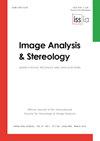Automated Evaluation of Contact Angles in a Three-Phase System of Selective Agglomeration in Liquids
IF 1
4区 计算机科学
Q4 IMAGING SCIENCE & PHOTOGRAPHIC TECHNOLOGY
引用次数: 2
Abstract
This study aims to an automated evaluation of contact angles in a three-phase system of selective agglomeration in liquids. Wetting properties, quantified by contact angles, are essential in many industries and their processes. Selective agglomeration as a three-phase system consists of a suspension liquid, a heterogeneous solid phase and an immiscible binding liquid. It offers the chance of establishing more efficient separation processes because of the shape-dependent wetting properties of fine particles (size ≤ 10 µm). In the present paper, an experimental setup for contact angle measurements of fine particles based on the Sessile Drop Method is described. Moreover, a new algorithm is discussed, which can be used to automatically compute contact angles from image data captured by a high-speed camera. The algorithm uses a marker-based watershed transform to segment the image data into regions representing the droplet, the carrier plate coated by fine particles, and the background. The main idea is a parametric modelling approach for the time-dependent droplet’s contour by an ellipse. The results show that the development of the dynamic contact angles towards a static contact angle can be efficiently determined based on this novel technique. These findings are useful for a detailed discrimination of wetting properties of spherical and irregularly shaped particles as well as their wetting kinetics. Also, a better understanding of selective agglomeration processes will be promoted by this user-friendly method.液体中选择性团聚三相系统接触角的自动评价
本研究的目的是在液体中选择性团聚的三相系统中的接触角的自动评估。通过接触角量化的润湿性能在许多工业及其过程中都是必不可少的。选择性团聚是一个由悬浮液、非均相固相和非混相结合液组成的三相体系。由于细颗粒(尺寸≤10 μ m)的形状相关润湿特性,它提供了建立更有效分离过程的机会。本文介绍了一种基于固滴法测量细颗粒接触角的实验装置。此外,本文还讨论了一种从高速摄像机采集的图像数据中自动计算接触角的算法。该算法使用基于标记的分水岭变换将图像数据分割为代表液滴、覆盖细颗粒的载体板和背景的区域。主要思想是用椭圆对随时间变化的液滴轮廓进行参数化建模。结果表明,基于该方法可以有效地确定动态接触角向静态接触角的演变。这些发现有助于详细区分球形和不规则形状颗粒的润湿特性及其润湿动力学。此外,这种用户友好的方法将促进对选择性团聚过程的更好理解。
本文章由计算机程序翻译,如有差异,请以英文原文为准。
求助全文
约1分钟内获得全文
求助全文
来源期刊

Image Analysis & Stereology
MATERIALS SCIENCE, MULTIDISCIPLINARY-MATHEMATICS, APPLIED
CiteScore
2.00
自引率
0.00%
发文量
7
审稿时长
>12 weeks
期刊介绍:
Image Analysis and Stereology is the official journal of the International Society for Stereology & Image Analysis. It promotes the exchange of scientific, technical, organizational and other information on the quantitative analysis of data having a geometrical structure, including stereology, differential geometry, image analysis, image processing, mathematical morphology, stochastic geometry, statistics, pattern recognition, and related topics. The fields of application are not restricted and range from biomedicine, materials sciences and physics to geology and geography.
 求助内容:
求助内容: 应助结果提醒方式:
应助结果提醒方式:


